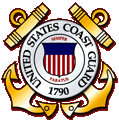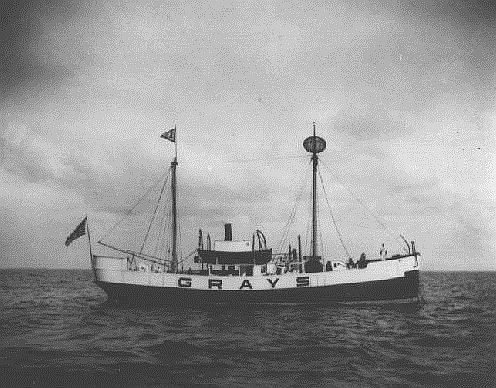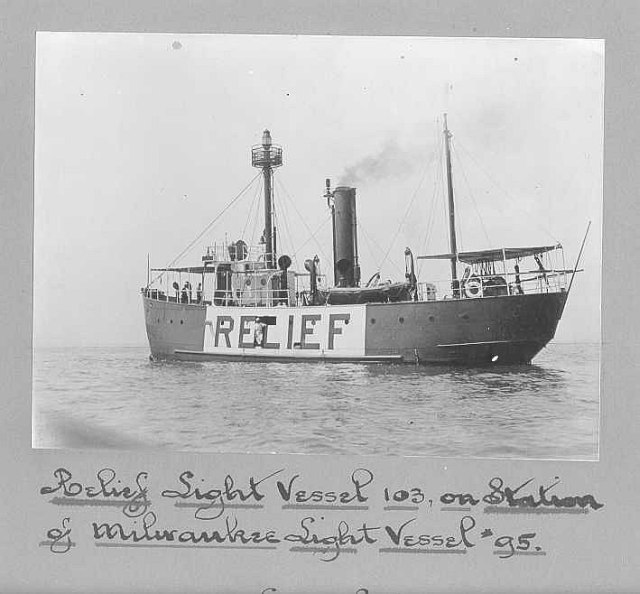



![]()


![]()
1891-1936
Location & historical notes: Michigan, on the northern edge of Lake Michigan, moored off the eastern end of Grays Reef. The station was replaced by the Grays Reef Lighthouse.
Lightships assigned:

1891-1923: LV-57
YEAR BUlLT: 1891
BUILT AT: Toledo (OH)
APPROPRIATION: $60, 000
BUILDER: Blythe Craig Shipbuilding Co
CONTRACT PRICE: $14,225 ($42,675 for 3 ships)
SISTER VESSELS: LV 55,56
DESIGN: Wood framed & planked; white oak fastened with 5/8"
square iron spikes;
2 masts, daymark on fore; spencer mast aft of main for riding sail; stack on
deckhouse amidships
LENGTH: 102'8" (loa); BEAM: 20'; DRAFT: 89"; TONNAGE: 130 gross
PROPULSION: Steam screw-one single cylinder non-condensing engine, 14" bore 16" stroke, 100 IEP; fire-tube boiler 5'dia x 9'lg; max speed 8 knots
ILLUMINATING APPARATUS: Cluster of 3 oil burning lens
lanterns hoisted to each mast head
FOG SIGNAL: 6" steam whistle, hand operated bell
CONSTRUCTION NOTES - MODIFICATIONS - EQUIPMENT CHANGES & IMPROVEMENTS: LV 57
-One of 3 vessels designed for use only during the navigation season on the
Great Lakes, as an experiment to avoid the high initial and recurring costs for
a permanent lighthouse. Maintenance and operating cost for each lightship was
estimated at $4,000 per year. Each had enough power for getting to and from
station. Mooring, consisting of a 5 ton sinker and 15 fathoms of 2 inch chain
was pre-positioned permanently and buoyed, eliminating the need (and cost) for
the lightship to carry mushrooms and chain
-Upon delivery many construction defects were found during sea trials, and many
interior modifications had to be made for comfort of the crew
-This and 2 sister vessels were first US lightships to be propelled by machinery
-1891: Masts found unnecessarily long and were shortened during winter layup
-1893: Fog bell added
-1907: Equipped with submarine bell
STATION ASSIGNMENTS: LV 57
1891-1923: Grays Reef (MI)
(1896: Apr 26, position moved 3150 feet SE x E)
HISTORICAL NOTES: LV 57
-1891: Sep 14/15, turned over to Lighthouse Establishment at Detroit
-1891: Oct 2 5,6, sea trials conducted; many defects noted; fitted out
-1891: Oct 19, departed Detroit, reaching Port Huron in evening
-1891: Oct 20, LV 55,56 & 57, using their own power to assist were taken in tow
by tender DAHLIA, making 9 knots, laying over at Sand Beach Harbor of Refuge due
to bad weather
-1891: Oct 24, placed on Grays Reef (MI), northerly end of Lake Michigan
-1891: Nov 17-20, left station without orders and put in to Cheboygan (MI); crew
discharged for dereliction of duty; replaced by others "more trustworthy";
replaced on station by tender DAHLIA, remaining until close of navigation at
which time went into winter quarters at Cheboygan. Many deficiencies due to
missing, incomplete or faulty equipment were corrected during winter and masts
were shortened
-1892: Apr 14, resumed station until Dec 7, then wintered at Cheboygan
-1892-1907: maintained station Apr/May to Dec, wintering at Cheboygan (Sturgeon
Bay WI in 1907) Needed repairs carried out each year in winter quarters
-1896: Fog signal characteristic changed to sound 2 blasts of 1 second each;
silent 20 seconds then 1 blast of 3 seconds; silent 15 seconds
More notes: LV 57
-1896: Fog signal operated 353 hours, consuming 15 tons coal & 2 cords wood
-1898: Boiler retubed; smokestack replaced; deck houses enlarged and improved
-1899: Hull recaulked above water line
-1900: Boiler and hull repairs
-1901: Extensive rot found in frames, planking and deck; unsound timbers and
planking replaced; hull recaulked and painted
-1901: Apr 26, position moved 3,150 feet SE x E in 24 feet
-Remained assigned to Grays Reef through 1923
RETIRED FROM LIGHTSHIP DUTY: 1923; AGE: 32
SUBSEQUENT DISPOSIT ION: Not listed in records after FY 1924, assume sold
COMMANDING OFFICERS: LV 57
1892-?: Maynard S Corlett, Master
?-1914: Peter D Ance, Mate
1914-?: Peter D Ance, Master
1914-1916: Thorwald Berntsen, Mate
1916-1917: Olaf J Nelson Mate
1917: Reinhart Larsen, Mate
1917: Fred P Klaus, Mate (temp)
1917: Lewis N Allard, Mate (temp)

1924-1926: LV-103 / WAL-526

YEAR BUILT: 1920
BUILT AT: Morris Heights (NY)
APPROPRIATION: ?
BUILDER: Consolidated Shipbuilding Co
CONTRACT PRICE: $161,074
SISTER VESSELS: None
DESIGN: Steam screw; steel hull; tubular lantern mast forward, small jigger mast
aft; steel pilothouse at foot of lantern mast; smokestack amidships
LENGTH: 96'5" (loa); BEAM: 24'0"; DRAFT: 9'6"; TONNAGE: 310 displ (fresh water)
PROPULSION: Steam - one compound reciprocating engine, 175 IHP; 2 coal fired Scotch boilers
ILLUMINATING APPARATUS: One acetylene lens lantern, 300mm
FOG SIGNAL: 10" steam whistle; hand operated bell
CONSTRUCTION NOTES - MODIFICATIONS - EQUIPMENT CHANGES & IMPROVEMENTS: LV 103-
1920: Dec 3/4, sea trials and conditional acceptance-
1921: Jun 9, delivered to 12th District Hq, Milwaukee-
1924: Submarine bell signal installed; discontinued 1931-
1927: Illuminant changed from acetylene to electricity-
1933: Fog signal changed to steam diaphragm horn (17" Leslie typhon)-
1934: Radiobeacon installed-
1934: Illuminating apparatus changed back to acetylene operation-
1935: Radiobeacon synchronized with fog signal for distance finding-
193?: Illuminating apparatus converted to duplex electric 375mm lens lantern,
15, 000cp-
1948: Repowered with twin inăline GM 671 diesels 34011?, max speed 9 knots-
1962: USCG lists F2T air diaphone, CR103 radar, other characteristics as above-
Radio and visual call sign NMGS (1940-1970)
STATION ASSIGNMENTS: LV 103/WAL 526
1921-1923: Relief
1924-1926: Grays Reef (MI)
1927-1928: Relief (12th District)
1929: Grays Reef (MI)
1929-1933: Relief (12th District)
1934-1935: North Manitou Shoal (MI)
1935: Relief (11th District)
1936-1970: Lake Huron (MI)
(Hull color changed from red to black - 1936)
(1942-1945: During WWII remained assigned to Lake Huron station)
HISTORICAL NOTES: LV 103 / WAL 526-
1920: Dec 3/4 sea trials completed in New York, conditionally accepted-
1921: steamed to Maine, picked up by HIBISCUS May 18 and towed (with LV 99) to
St Lawrence River entrance; both lightships then steamed to Ogdensburg NY, met
by CROCUS and escorted to Detroit, LV 103 then steamed to Milwaukee arriving Jun
9 and assigned Relief duty-
1936: Hull color changed from red to black when placed on Huron station.-
From 1945 onward, this was the only black lightship in service.
RETIRED FROM LIGHTSHIP DUTY: 1970; AGE: 50
SUBSEQUENT DISPOSITION: Decommissioned Aug 25, 1970; donated to the town of Port Huron (MI), Port Huron Marine Museum; marked HURON; dry berthed and on display in park; she is open for tours on Fridays from 1:00 to 8:00 p.m. (May 17-September 27) and daily from 1:00 to 4:30 pm in the summer. For more information call them at: (810) 982-0891 or visit their website at www.phmuseum.org. Last surviving lightship on the Great Lakes
COMMANDING OFFICERS: LV 103 / WAL 526
1920-?: Hiram S Hill, Master
1957-1958: BMC Milo V. Collins, OIC*
1958-1959: BMC McDonald, OIC (Former Lighthouse Service employee)*
1959-?: BMC William Buxton, OIC*
1962: BMC Leon DeRosia, OIC

1927-1928: LV-56
YEAR BUILT: 1891
BUILT AT: Toledo (OH)
BUILDER: Blythe Craig Shipbuilding Co
APPROPRIATION: $60,000
(Approp. for 3 ships-Simmons Reef, White Shoal, & Grays Reef)
CONTRACT PRICE: $14,225 ($42,675 for 3 ships)
SISTER VESSELS: LV 55,57
DESIGN: Wood framed and planked; white oak fastened with 5/8" square iron spikes
2 masts, daymark on foremast; spencer mast aft of main for riding sail; stack on
deckhouse amidships
LENGTH: 102'8" (loa); BEAM: 20'; DRAFT: 89"; TONNAGE: 130 gross
PROPULSION: Steam screw-one single cylinder non-condensing engine; 14" bore x 16" stroke, 100 IEP, fire-tube boiler 5' dia x 9'lg; max speed 8 knots
ILLUMINATING APPARATUS: Cluster of 3 oil burning lens lanterns hoisted to each mast head
FOG SIGNAL: 6" steam whistle, hand operated bell
CONSTRUCTION NOTES - MODIFICATIONS - EQUIPMENT CHANGES & IMPROVEMENTS: LV 56
-One of 3 vessels designed for use only during the
navigation season on the Great Lakes, as an experiment to avoid the high initial
and recurring costs for a permanent lighthouse. Maintenance and operating cost
for each lightship was estimated at $4,000 per year. Each had enough power for
getting to and from station. Mooring, consisting of a 5 ton sinker and 15
fathoms of 2 inch chain was prepositioned permanently eliminating the need (and
cost) for the lightship to carry mushrooms and chain - First US lightships with
propelling engine
-Upon delivery, many construction defects were found during sea trials, and many
interior modifications had to be made for comfort of the crew
-1891: Masts found unnecessarily long; shortened during winter layup
-1893: Fog bell added
-1910: Equipped with submarine bell signal
-1913: After spencer mast removed 1913/1914; hull lettering shortened to MANITOU
STATION ASSIGNMENTS: LV 56
1891-1909: White Shoal (MI)
1910-1926: North Manitou Shoal (MI)
1927-1928: Grays Reef (MI)
(White Shoal station discontinued 1909)
HISTORICAL NOTES; LV 56
-1891: Sep 14/15, turned over to Lighthouse Establishment at Detroit (MI)
-1891: Oct 2,5,6, sea trials conducted; many defects noted; fitted out
-1891: Oct 19, departed Detroit, reaching Port Huron in evening
-1891: Oct 20, LV 55,56 & 57 using their own power to assist were taken in tow
by tender DAHLIA, making 9 knots; laid over at Sand Beach Harbor of Refuge
due to bad weather
-1891: Oct 24, placed on White Shoal (MI), northerly end of Lake Michigan
-1891: Nov 17-20, left station without orders and put into Cheboygan; crew
discharged for dereliction of duty; replaced with others "more trustworthy";
vessel replaced on station by tender DAHLIA Nov 22, remaining until close of
navigation at which time put into Cheboygan winter quarters. Many deficiencies
due to missing, incomplete or faulty equipment were corrected during winter and
masts were shortened
-1892: Apr 14, resumed station until Dec 7; wintered at Cheboygan (MI)
-1892-1907: maintained station Apr/May to Dec, wintering at Cheboygan (Sturgeon
Bay WI in 1906). Needed repairs carried out each year in winter quarters
-1896: Fog signal in operation 371 hours consuming 17 tons coal & 2 1/2 cords
wood
More notes: LV 56
-1897: Smokestack replaced; deck houses enlarged and improved
-1898: Extensive interior modifications; boiler repairs
-1900: Due to rot, substantial amount of hull and deck planking replaced
-1902: Extensive hull repairs; stateroom built for Master
-1906: Extensive repairs to hull and machinery
-1909: Dec, withdrawn, White Shoal station discontinued
-1910: Placed on North Manitou Shoal (MI); remaining assigned through 1926
-1927: Placed on Grays Reef remaining through the 1928 season
RETIRED FROM LIGHTSHIP DUTY: 1928; AGE: 37
SUBSEQUENT DISPOSITION: Sold Dec 20, 1928
COMMANDING OFFICERS: LV 56
1892-1893: Samuel Dodd, Keeper
1893-?: Samuel Dodd, Master
?-1915: Charles B Corlett, Master
1915-1916: Richard D Baxter, Mate
1916-1917: Ervin Hartung, Mate
1917-1918: Hubert R Benson, Mate
1918-1921: Charles Cretean, Mate
1915-1918: Robert Bruce, Master
1918-1919: Albert F Pitman, Master
1920-1927: Edward A Hansen, Master
1921: John 0 Neil Jr, Mate
1922: Sigurd Frey, Mate
1922-1927: William J Stewart, Mate
1927-1928: William J Stewart, Master
1928: Louis A Anderson, Mate
? - 1929: LV-103 / WAL-526
{SEE ABOVE}

1929-1936: LV-99 / WAL-522
YEAR BUILT: 1920
BUILT AT: Boothbay Harbor (ME)
BUILDER: Rice Brothers
APPROPRIATION: ?
CONTRACT PRICE: $97,220
SISTER VESSELS: None
DESIGN: Steam screw; steel hull; single tubular lantern mast with gallery, short jigger mast aft for riding sail; steel pilot house with bridge; smokestack with fog whistle
LENGTH: 91'8" (loa); BEAM: 22'0"; DRAFT: 10'7"; TONNAGE: 215 displ, fresh water
PROPULSION: Steam -. one single cylinder engine, 125 IHP
ILLUMINATING APPARATUS: Single acetylene lens lantern
FOG SIGNAL: 10" steam whistle mounted on stack: hand operated bell
CONSTRUCTION NOTES - MODIFICATIONS - EQUIPMENT CHANGES & IMPROVEMENTS: LV 99-
1916: Jun 29, construction started but hull and other parts of vessel destroyed
by fire Jul 10 when 54% complete. New materials procured and vessel completely
rebuilt-
1919: Nov 7, launched: sea trials and conditional acceptance Nov 8/9-
1920: Dec 8, delivered by contractor-
1923: Equipped with submarine bell-
1930: Equipped with radiobeacon; illuminating apparatus electrified-
1931: Submarine bell discontinued-
Radio and visual call sign NNGI assigned 194.0ă19??-
1949/50: At USCG Yard, Curtis Bay, Md, propulsion and auxiliary machinery, shaft
and propeller removed; vessel than refitted and equipped for use as an unmanned
light vessel with capability for being remote controlled by radio - designated
EXP-99
(See listing for EXP 99 for further details)
STATION ASSIGNMENTS: LV 99 / WAL 522
1921-1929: Poe Reef (Ml)
1929-1935: Grays Reef (MI)
1937-1942: Overfalls (DE) (Our thanks to William Camp for this information.)
1942-1943: Examination Vessel, WWII
1943-1950: (located at Coast Guard Yard, Curtis Bay, ND)
1950: (Designated EXP-99, and moved to 3rd District
1950-1956: ?
Poe Reef station discontinued Aug 5, 1929
Grays Reef station discontinued 1936
1937 , Sept transferred to 2d District and towed to Boston
1942-1943: During WWII, assigned to 7th District, stationed at Port Everglades
(FL). and used as examination vessel; armed with one 3" gun and two 20mm.
1943-1950: Arrived Curtis Bay Yard 29 Mar 1943 arid commencing in 1949 vessel
was extensively modified for use as an experimental, radio controlled lightship
designated EXP 99, later referred to as Sandy Hook Experimental Lightship EXP.
Plans for placing it near Scotland Lightship during 1950 were indefinitely
postponed and the experimental vessel was apparently never used.
HISTORICAL NOTES: LV 99 / WAL 522-
1921: May 18, LV 99 and LV 103 towed from Maine to St Lawrence River entrance by
HIBISCUS; lightships then proceeded independently to Ogdensburg NY, met by
CROCUS and convoyed to Detroit. LV 99 placed in commission at Detroit Jul 21-
1921: Jul, placed on Poe Reef station-
1929: Assigned to Grays Reef until station discontinued in 1936-
1937: Sep, transferred to 2nd District and towed by tender HIBISCUS from
Milwaukee (WI) via St Lawrence River to Boston (Chelsea Depot)
1937-1942: Service on the Overfalls, DE, station. (Our thanks to William Camp
for this information.)
WWII service as an Examination Vessel.
Standard Distribution Lists, photos and correspondence show that the vessel was at the Curtis Bay Yard 1943-1950 where it was modified and refitted as an experimental, radio controlled lightship designated EXP-99. It was moved to the Third District in 1950 but plans for placing it on station near Scotland lightship did not materialize, and no further information on use and history could be found. (See EXP-99 BELOW for further details)
Modified version of LV 99./WAL 522 - Stern modified prior to 1943, stern tube welded shut, and all original machinery removed to accommodate equipment required for unattended operation, remotely controlled by radio from shore. This included three 20KW engine-generator sets (one operating, 2 standby) automatic bilge pumps, automatic fire extinguishing system, and two-way FM radio equipment which received coded radio signals from ashore, translating them to electro- mechanical signals for stopping and timing the operation of all installed equipment. Provision was also made for continuous monitoring of all systems and transmission of status data to the shore station. In addition to the illuminating apparatus and fog signal mentioned above, there were 2 sets of beacon gear (1 operating, 1 standby), an automated 1000lb fog bell, and an emergency battery power supply. The control system was developed by Westinghouse, the fog signal by RCA. Savings in annual operating costs were estimated at $59, 000 as compared to a conventional crewed lights-hip
STATION ASSIGNMENTS: EXP-99
Called SANDY HOOK EXPERIMENTAL LIGHTSHIP and following a two month period of continuous trial operation, was to have been placed near Scotland LI Lightship for evaluation, The control equipment was installed at the Sandy Hook Light station, and the lightship was moved from Curtis Bay to the Third District at Staten island about May 1950. However, establishment of the lightship station was postponed indefinitely, and no further reference to the vessel could be found.
The experimental lightship was apparently never placed in service.
(see historical notes)
HISTORICAL NOTES:EXP-99
Notices to Mariners contain the following:
1949 - New York Harbor, South Channel
NM Oct 8 - "About Jan 1, 1950 Sandy Hook Experimental Lightship EXP will be
established 5850 yards, 94 degrees 30 minutes from Sandy Hook Light - red hull,
EXE in white on sides, white superstructure, buff mast and gallery. Flashing red
light every 6 seconds (1 second flash), 2000cp light at 40 feet visible 12
miles; electric chime diaphragm horn, 1 blast every 10 seconds (two second
blast), Class B radiobeacon, range 10 miles, 298kc, (._.. ), 60 seconds on, 120
seconds off during 1st and 4th ten minute period of each hour in clear weather;
continuous use in fog or low visibility. Note - lightship is unmanned and
controlled from ashore. Position: 40 27.5 - 73 56.4." (this would place it about
1.3 mi - 315 degrees from Scotland Lightship)
1950 - New York Harbor, South Channel
NM Jan 7 - "Establishment of Sandy Hook Experimental Lightship has been postponed indefinitely." (No further reference found in NMs through 1955)
More notes:
A news release dated April 29, 1950 describing the experimental lightship and
stating that it was to be placed on station during the summer of 1950 was
carried by the New York Times and other newspapers. A similar write up with
photographs appeared in the Coast Guard Magazine, and descriptive material and
drawings appeared in Popular Science magazine
In the light of all the advance publicity, it is indeed peculiar that no follow-up explanation or reason for the postponement was presented in the media, and equally peculiar that no official records can be found- which address either the undertaking itself, or subsequent events and disposition of the vessel
It is concluded that the experimental lightship EXP-99 was never placed on station, and later history of the vessel is either non-existent or unavailable
RETIRED FROM LJGHTSHIP DUTY: ?; AGE: ?
SUBSEQUENT DISPOSITION: Coast Guard records show only that LV 99./WAL 522 was decommissioned May 4, 1956 and sold Nov 5, 1956
RETIRED FROM LIGHTSHIP DUTY: 1956; AGE: 35
SUBSEQUENT DISPOSITION: Decommissioned May 24, 1956; sold Nov 5, 1956
COMMANDING OFFICERS: LV 99 / WAL 522
1921-1929: Ernest Lebahn, Master
1921: Charles Bernier, Mate
1921-1928: Walter McCash, Mate
1929-?: John A Renehan, Mate
1929-?: Harry McRae, Master
![]() Back to Lightship
Stations and the Ships that Served on them.
Back to Lightship
Stations and the Ships that Served on them.
Copyright © 2004 United States Coast Guard Lightship Sailors Association
INC. All rights reserved.
Copyrights also protected by the
Digital Millennium Copyright Act of
1998
Revised: 10/23/06.